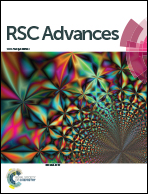The therapeutic effect of Bletilla striata extracts on LPS-induced acute lung injury by regulation of inflammation and oxidation†
Abstract
Bletilla striata, a widely used traditional herbal medicine, has been shown to exhibit various biological activities but its antioxidative and anti-inflammatory activities have not been well studied. In this study, we isolated the active ingredients from B. striata, and identified the ingredient structures from the highest antioxidative fraction BM60 using HPLC-ESI-HRMS and then investigated the antioxidative and anti-inflammatory responses and the underlying mechanisms of fraction BM60 both in vitro and in vivo. The BM60 treatment reduced the production of NO in NR8383 macrophages. In addition, acute lung inflammation was induced in mice by intratracheal instillation of lipopolysaccharide (3.0 mg kg−1), and treatments with BM60 at the doses of 35, 70, 140 mg kg−1 significantly reduced macrophages and neutrophils in the bronchoalveolar lavage fluid (BALF) and markedly ameliorated lung wet-to-dry weight (W/D) ratios, myeloperoxidase (MPO) activity and pulmonary histopathological conditions. Moreover, the treatment might be attributed to the down-regulations of neutrophil infiltration, malondialdehyde (MDA) and up-regulations of superoxide dismutase (SOD) in lung tissues. In addition, the BM60 treatment inhibited the infiltration of inflammatory cells and tumour necrosis factor-α (TNF-α), interleukin-1β (IL-1β), and interleukin-6 (IL-6) production. The results from histopathological and immunochemical analyses confirmed the above biochemical assay data. The preliminary mechanistic study indicated that BM60 suppressed LPS-induced nuclear factor-κB (NF-κB) activation in a dose-dependent manner. Therefore, this work prompted further evaluation of B. striata to discover individual active ingredients for preventing acute lung injury in the future.



 Please wait while we load your content...
Please wait while we load your content...